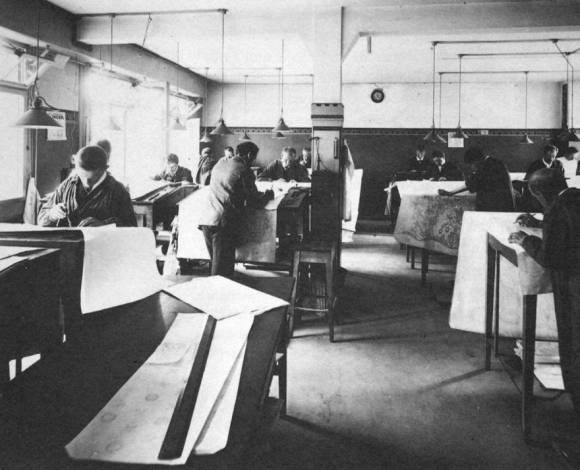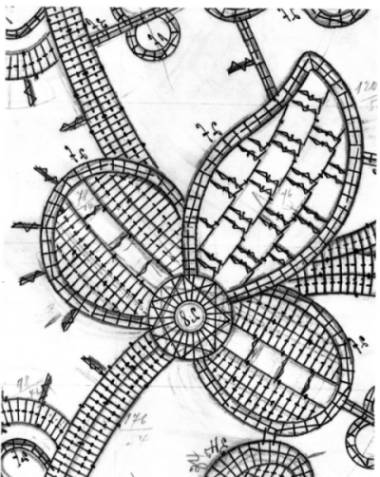
In this workshop the enlargers
transform the design into a technical pattern

Detail of technical drawing,
motif 6 times enlarged
| ANNE WANNER'S Textiles in History / publications |
| The Sample Collections of Machine Embroidery
of Eastern Switzerland in the St Gallen Textile Museum in: Textile History, 22 (2), p. 165 - 176, 1992, by Anne Wanner-JeanRichard |
| page 8 of 10 back - next |
| The Types of Embroideries Produced (22) |
| The fabric to be embroidered
is called plain cloth or Stickboden, and it is
fastened into the embroidery machine. The length of the
material was dependent on the type of embroidery machine;
the hand machine often measured as much as 4.5 metres in
width. Since two widths of fabric could be worked one on
top of the other, it was possible to embroider 4.5 metres
of fabric twice on one machine. The designer drew the patterns in the size in which they were later to be embroidered but for working, the individual Rapporte (motifs) were entlarged by six by the enlarger, and divided into individual embroidery stitches. Home workers or factory workers embroidered according to these enlarged pattern-cards. These operations were liable to have flaws so that hand-machine and Schiffli machine embroideries had to undergo careful inspection and correction. These goods then had to go through a second process, the checking. A further procedure, the finishing, gave the embroideries a better appearance, through singeing, bleaching and dressing. During singeing, the fabrics were passed at speed over gas jets and any protruding fibres, thread ends or hair, burnt off. During the bleaching and dressing process the embroideries beame radiantly white. |
White embroideries
can be divided into various articles. Allover is
a pattern spread evenly over the background, while Entredeux
(insertions) are embroidered strips fastened between two
fabrics. Bandes (edgings), on the other hand,
are used for the decoration of seams or edges, and the
so-called Galons are strips embroidered on both
sides which can be fastened to a material as a decorative
braid. Motifs are isolated figures like flowers,
animals or people. These were sewn on to fabrics, and
sometimes the material underneath the embroidery cut away
so that the motifs are insert into shirts, blouses,
dresses, etc. With coloured embroidery, the appliqué technique was mostly used. This technique provided a solution to a problem with which especially the machine embroidery was faced. If the design was embroidered directly on to lengths of good quality fabric the goods became very expensive. The new process consisted in the design's separation into various parts which could be produced in bulk on cheap cotton fabric. The back side had a stiff rubber coating which enabled the worker to cut the patterns accurately by hand and subsequently seam it on to any kind of material, thus transforming it into one piece again. Numerous examples of these products are kept in the St Gallen textile library (23). |
|
|
|
|
|
| One speciality of coloured embroidery from the early periods of the twentieth century should be mentioned, embroidered postcards for Christmas, the New Year and Easter which initially were produced near Paris. The hand-machine embroiderer Otto Huber (Necker-Toggenburg) relates how he embroidered such cards in France after 1904 (24). During the First World War, these cards were so popular among the allied soldiers that embroiderers with experience in coloured embroidery received orders from abroad. Collections of these cards are kept in the textile museum. |
Embroidered postcard |
Embroidered postcard |
| References: 22 - Terms and explanations can be found in: Adolf Naef, Die Organisation eines Stickereibetriebes (St. Gallen, 1911). |
23
- Siegfried, 24 - Urs Hochuli und Bernhard Bischoff,
Günterli und Aaterdö (St. Gallen, 1987), p. 6.Aus
dem Bilderbuch eines Lebens, p.
120. |
| Introduction | Rittmeyer | Grauer | Alder | Ikle | Tschumper | Fraefel | Types | Lace | Reports |
| content | Last revised 25 July, 2004 |